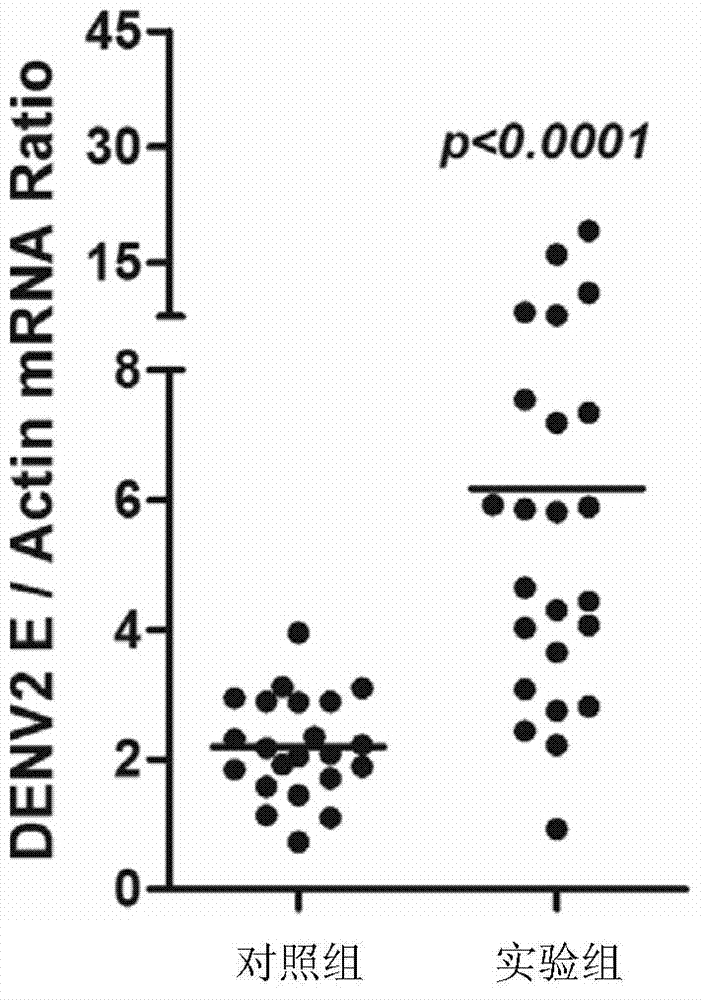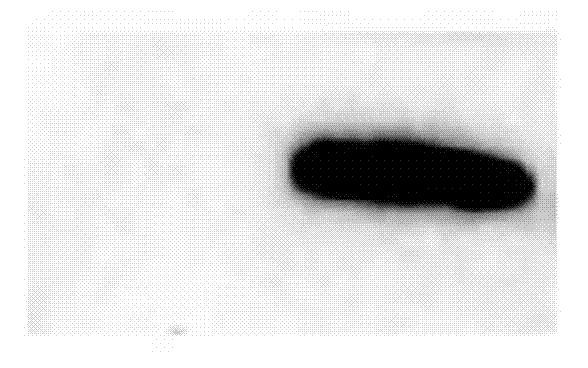Cecropins obtained from Aedes aegypti, coding gene and applications thereof
A coding and gene technology, which is applied in application, genetic engineering, plant genetic improvement, etc., can solve the problem of limiting the growth of viruses or other pathogenic microorganisms, and achieve the effects of reducing infection ability, broad application prospects, and reducing inhibition
- Summary
- Abstract
- Description
- Claims
- Application Information
AI Technical Summary
Problems solved by technology
Method used
Image
Examples
Embodiment 1
[0037] Example 1, DENV-2 induces the expression of AaCECN gene in Aedes aegypti
[0038] 1. Group processing
[0039] Experimental group (24 Aedes aegypti): Inoculate Aedes aegypti with dengue type 2 virus (10MID per Aedes aegypti via pleural injection) 50 DENV-2 with an injection volume of 300nL);
[0040] Control group (22 Aedes aegypti): Each Aedes aegypti was injected with 300nL PBS buffer through the chest cavity.
[0041] 2. Six hours after the inoculation in step 1, the total RNA of Aedes aegypti was extracted and reverse-transcribed into cDNA, and the expression of AaCECN gene in Aedes aegypti was detected by fluorescent quantitative PCR (SYBR Green) (Actin gene was used as an internal reference).
[0042] The primers used to identify the AaCECN gene are as follows:
[0043] Upstream primer: 5'-CGGCAAGAAATTGGAAAAAGTC-3';
[0044] Downstream primer: 5'-GAATCGATCATCCTAGGGCC-3'.
[0045] The primers used to identify the Actin gene are as follows:
[0046] Upstream p...
Embodiment 2
[0049] Embodiment 2, the application of the substance that suppresses AaCECN gene expression in promoting dengue fever virus replication
[0050] 1. Preparation of dsRNA
[0051] 1. The primers designed to prepare the coding DNA of the dsRNA that inhibits AaCECN gene expression are as follows:
[0052] AaCECN-F: 5'- GCGCTCCGTCGATCAAGTTC-3';
[0053] AaCECN-R: 5'- CAGTGTCTTTTCACAATTTAAATCAG-3'.
[0054] In the above primers, the framed region is the T7 promoter sequence.
[0055] 2. Extracting the total RNA of Aedes aegypti and reverse-transcribing it into cDNA, using the cDNA as a template, performing PCR amplification with a primer pair composed of AaCECN-F and AaCECN-R to obtain a PCR amplification product.
[0056] 3. Take the PCR amplification product obtained in step 2, use Ambion MEGAscriptT7High Yield Transcription Kit (catalogue number: AM1334) and perform in vitro transcription according to the kit instructions. Since both AaCECN-F and AaCECN-R have T7 promoter...
Embodiment 3
[0081] Embodiment 3, the application of AaCECN protein in inhibiting virus replication
[0082] 1. Construction of recombinant plasmid pMT-AaCECN-V5-HisA
[0083] 1. Synthesize single-stranded DNA molecule A and single-stranded DNA molecule B respectively, and obtain double-stranded DNA molecules after annealing (in single-stranded DNA molecule A and single-stranded DNA molecule B, the part in the recognition sequence of the restriction endonuclease is underlined , the resulting double-stranded DNA molecule has a sticky end of the restriction endonuclease BglII upstream and a sticky end of the restriction endonuclease XhoI downstream).
[0084] Single-stranded DNA molecule A:
[0085] 5'- GATCT CAGCAACAGTGCGGCGTGGAAGCGGCGCCCAGGTGGAAATTCGGCAAGAAATTGGAAAAAGTCGGGAAAAATGTGTTTAACGCTGCTAAGAAGGCACTGCCAGTCGTTGCCGGGTACAAGGCCCTAGGA C -3'
[0086] Single-stranded DNA molecule B:
[0087] 5'- TCGAG TCCTAGGGCCTTGTACCCGGCAACGACTGGCAGTGCCTTCTTAGCAGCGTTAAACACATTTTCCCGACTTTTTCCAATTTCTT...
PUM
 Login to View More
Login to View More Abstract
Description
Claims
Application Information
 Login to View More
Login to View More - R&D
- Intellectual Property
- Life Sciences
- Materials
- Tech Scout
- Unparalleled Data Quality
- Higher Quality Content
- 60% Fewer Hallucinations
Browse by: Latest US Patents, China's latest patents, Technical Efficacy Thesaurus, Application Domain, Technology Topic, Popular Technical Reports.
© 2025 PatSnap. All rights reserved.Legal|Privacy policy|Modern Slavery Act Transparency Statement|Sitemap|About US| Contact US: help@patsnap.com



